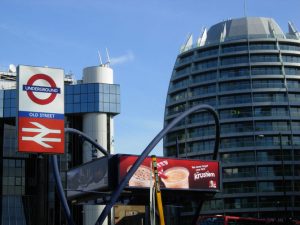At the end of last year, The Argus ran a story comparing Brighton’s London Road to Shoreditch in London.
I’m sure I wasn’t the only one to choke on my coffee when reading this headline; at first glance, it seems ludicrous to compare the two places.
For a start, Shoreditch and its environs (Old Street, Hoxton, Dalston) together make up a pretty sizeable chunk of East London; in contrast, London Road is just that – one road.
And while the re-imagining of Shoreditch has so far involved a welter of new hotels, office blocks, clubs, bars and art galleries, London Road has seen little more than a couple of renovated pubs and a few coffee shops.

The ‘Silicon Roundabout’ near Shoreditch is home to many startups and large technology firms. Stephen McKay, CC BY-SA
On the other hand, if we expand the London Road district to also include the North Laine, there are some definite parallels between the two areas – one being that both are hotbeds for startups and new media businesses.
The Shoreditch area of London has been dubbed ‘Tech City’ by the government, reflecting a rapid increase in the number of technology-related businesses being created in the area.
The epicentre for this is Old Street’s Silicon Roundabout, where agile startup companies rub shoulders with major tech firms such as Google and Amazon.
While not on the same scale, the London Road/North Laine district has seen a similar rise in new companies specialising in areas such as software development and digital marketing.
Companies such as Brandwatch and iCrossing are home‑grown success stories, and the decision of a large US technology company to establish a presence in Brighton may be a sign that the city’s tech sector has reached critical mass.
The tech cluster in Shoreditch owes some of its success to its large population of young people, many of whom are immigrants from around the world; economist Douglas McWilliams argues in his book ‘The Flat White Economy’ that this mixing of cultures is a crucial factor in encouraging innovation.

The disused Astoria Theatre near London Road, which has recently been bought by the Student Housing Company
Likewise, the streets around London Road are already home to a large number of students from the city’s two universities, many of whom are from overseas.
This population looks set to increase with the recent completion of the Abacus House student accommodation, and the purchase of the defunct Astoria Theatre by The Student Housing Company.
However, while there is much about Shoreditch that can be held up as an example of good practice, its success has come at a cost.
Living space in the area is much in demand, and rising house prices mean that Shoreditch is now unaffordable for many of the students and young creative types that helped to build its reputation as a centre for art and culture. Soaring office rents are forcing many startups out of the area.
There have also been warnings that Shoreditch is at risk of ‘Canary Wharf-isation’ as developers rush to build skyscrapers to cash in on the district’s popularity.
There is a lesson here for Brighton and Hove City Council as they consider the future of the city’s technology cluster. While they would be right to encourage further growth, care must be taken to avoid pricing current residents out of the area.
In order to ensure that London Road remains a haven for students and young professionals at the start of their careers, it is vital that we build more affordable housing and office space. This way we will echo Shoreditch’s success, without repeating its failures.